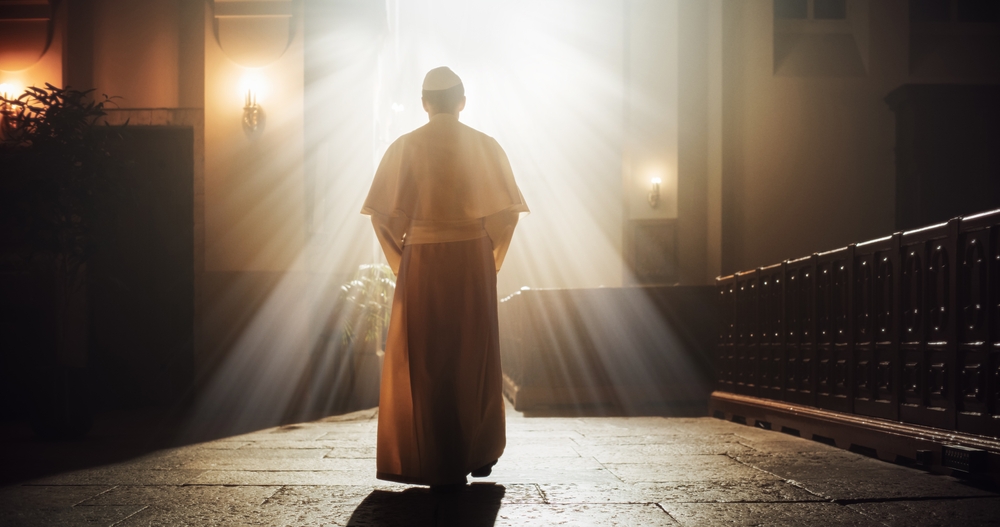Experts claim description of Jesus in the Bible is ‘completely off the mark’ as they reveal what he really looked like

For most of us, the image of Jesus is so familiar that we don’t question it. We picture a fair-skinned, long-haired man with soft features, often depicted in golden-hued paintings. This image has been ingrained in our culture for centuries—so much so that it’s hard to imagine him any other way. But what if this portrayal is nothing more than a historical misstep? What if the figure we’ve come to worship and admire looks vastly different from what we’ve been shown?
Imagine how you might feel if you were told that the most famous historical figure of all time has been misrepresented for centuries. It’s like learning that the person you’ve admired all your life looks nothing like you imagined. Intriguing, right? Yet, that’s exactly what experts are now suggesting: the description of Jesus in the Bible may be “completely off the mark.”

The Biblical Description of Jesus: What We Actually Know
The Bible is often considered the ultimate source of truth for understanding Jesus’ life and mission. Yet, when it comes to his physical appearance, the scriptures offer remarkably little. In fact, the New Testament contains almost no direct description of Jesus’ looks. The closest we get are indirect references that don’t offer much detail beyond a few scattered clues. For example, in the book of Isaiah, there’s a prophecy that hints at his appearance: “He had no beauty or majesty to attract us to him, nothing in his appearance that we should desire him” (Isaiah 53:2). This suggests that Jesus wasn’t the type of figure one would find strikingly handsome or particularly distinguished by physical traits. But this description is vague at best and leaves a lot to our imagination.
The lack of detail about Jesus’ appearance might seem odd, especially considering his significance in religious texts. However, this absence could be intentional. The focus of the Gospels was never about his outward appearance, but about his actions and the messages he delivered. For early Christians, the essence of Jesus’ life and mission lay in his teachings, death, and resurrection, not his physical characteristics. This might explain why there was no great emphasis on describing his looks in the texts that were passed down. After all, his divinity and message were meant to transcend appearances. Yet, over time, the absence of a clear description opened the door for a multitude of interpretations.
As Christianity spread across different regions and cultures, artists began to imagine Jesus in ways that resonated with their own societies. This led to a wide range of artistic depictions of Jesus, often based on the cultural norms and ideals of the time. In Western art, particularly during the Renaissance, Jesus was often portrayed as a light-skinned, European figure with long, flowing hair, and soft features. These representations were more reflective of European ideals of beauty than they were of any historical accuracy. But these depictions took hold, and over centuries, they became the default image of Jesus for much of the world. This lack of a concrete biblical description meant that popular images of Jesus were largely shaped by the prevailing cultures of the artists, rather than by historical evidence.

Modern Research and Expert Opinions: A New Perspective
Over the years, historians and scholars have begun to examine what Jesus might have actually looked like using new methods and a broader understanding of history and culture. Some researchers have turned to forensic anthropology, which uses knowledge of skeletal remains and the study of ancient populations to make educated guesses about a person’s appearance. This field of study has been used to reconstruct the faces of ancient figures, including famous historical figures whose physical appearances were not documented in their lifetimes. By examining the geography, culture, and ethnicity of Jesus’ time, these experts are challenging the long-standing image of a fair-skinned, European Jesus.
One significant aspect of this new research focuses on Jesus’ origins. Jesus was born in the region of Judea, which is now modern-day Israel and Palestine. He lived in a time when people of that region were Middle Eastern Jews. This geographical context means that Jesus would likely have had the physical characteristics common to the people of that area. Experts suggest that, instead of the fair-skinned, blue-eyed figure we often see in Western depictions, Jesus was probably of darker complexion, with olive-toned skin, dark hair, and brown eyes. These traits align with what we know about the people who lived in the Mediterranean region during the first century.
Furthermore, some researchers have used anthropological models and historical records to reconstruct what a typical man of Jesus’ age and region would have looked like. This method involves considering the clothing, hairstyles, and body types common to the time, as well as the environmental conditions that would have influenced Jesus’ appearance. These findings point to a man with short, dark hair and a beard, as was common for Jewish men at the time. His features would have been consistent with the typical physical traits of Middle Eastern men of his time, dispelling the Eurocentric depictions that have dominated for centuries. This new perspective helps us envision Jesus in a more historically accurate light, grounding him in the reality of the world he lived in.

The Role of Art in Shaping Our Perception
Art has long played a significant role in shaping public perception, especially when it comes to religious figures. Throughout history, artists have been responsible for translating abstract concepts into visual forms that resonate with the people of their time. When it came to depicting Jesus, artists were influenced not only by religious traditions but also by the cultural norms and aesthetic values of their respective societies. This is why early Christian art, often produced in Roman-controlled regions, portrayed Jesus with elements familiar to the viewers—such as a youthful, idealized appearance and Roman-style clothing. As Christianity spread through Europe, particularly during the Renaissance, artists began to depict Jesus as a divine figure, often reflecting the ideals of beauty and masculinity that were prevalent in European culture at the time.
The Renaissance period, in particular, had a profound impact on the image of Jesus. Artists like Leonardo da Vinci, Michelangelo, and Raphael created works that portrayed Jesus as a refined, ethereal figure, consistent with the European artistic tradition of idealized human forms. This portrayal was not based on historical evidence or cultural context but rather on the aesthetic preferences of the artists. These images were meant to convey Jesus’ divinity and purity, which led to the creation of a fair-skinned, almost angelic Jesus. As a result, this European depiction of Jesus became widespread and deeply ingrained in Western religious art, influencing how generations of Christians envisioned Christ.
What’s fascinating is how these artistic representations have shaped our perception of Jesus today. In many ways, the image of Jesus as a European figure is so deeply embedded in Western culture that it’s difficult for many people to imagine him any other way. However, as new research and expert opinions shed light on the actual physical traits of Jesus, it challenges these ingrained perceptions. The image of Jesus as a Middle Eastern man with darker features is not just a matter of historical accuracy; it is also a reminder of the importance of representation in art and the way it influences our understanding of historical and religious figures. It pushes us to reconsider how we interpret religious iconography and the way it affects our collective identity.

What Experts Say Jesus Really Looked Like
Recent expert reconstructions based on historical, archaeological, and anthropological research paint a drastically different picture of Jesus. Instead of the fair-skinned, long-haired figure often seen in Western depictions, experts suggest that Jesus was most likely a man with a darker complexion, typical of the Jewish people in the Middle East during the first century. According to forensic anthropologist Dr. Richard Neave, who has worked on recreating faces from ancient remains, Jesus’ skin tone would have been more olive-toned, and his hair would have been dark and curly. This is in line with the physical traits common to the region at the time, providing a more accurate visual representation of Jesus based on the people and culture of his era.
Additionally, Jesus’ hair would have been much shorter than the long, flowing locks often depicted in popular art. The Gospels do not give a clear description of his hair length, but it was customary for Jewish men of the time to have shorter hair and beards, in accordance with cultural and religious practices. This contrasts sharply with the often idealized and exaggerated images of Jesus created during the Renaissance, which presented him with long, perfectly groomed hair and a delicate, almost otherworldly look. Experts argue that Jesus’ appearance would have been far more rugged and earthly, aligning with his status as a carpenter and a man of humble means.
Finally, it’s important to note that Jesus would have likely had a broader, more muscular build than what is typically shown in Western depictions. Living in a physically demanding society, working with his hands as a carpenter, Jesus would have been accustomed to physical labor, which would have shaped his physique. Experts suggest that he was likely around 5’1″ to 5’5″ tall, with a robust and sturdy build, characteristics common to men from the region at the time. This reconstruction of his physical appearance offers a more grounded, relatable image of Jesus that contrasts with the ethereal, distant figure we often see in art and popular culture. By understanding these new insights, we can begin to form a more historically accurate image of who Jesus truly was, beyond the artistic reinterpretations that have shaped our perceptions for centuries.

The Impact of This New Image on Faith and Culture
As these new findings about Jesus’ true appearance emerge, they spark important conversations about faith, identity, and cultural representation. For many, the image of Jesus has been a symbol of spiritual purity and divine love, but it has also been tied to centuries of cultural and religious traditions. The traditional Western depiction of Jesus as a fair-skinned, European figure has become synonymous with Christ for much of the world. However, as experts challenge this image, it forces us to confront the ways in which culture and art have shaped our perceptions of sacred figures.
The revelation that Jesus likely looked more like a typical Middle Eastern man of his time has significant implications for how we think about religious figures and representation. For some, it may feel like a challenge to long-held beliefs, especially in societies where the European depiction of Jesus has been so entrenched. For others, it may offer a new perspective that aligns more closely with the historical and geographical reality of Jesus’ life. The conversation surrounding Jesus’ appearance underscores the importance of questioning historical narratives and the way art influences how we view the world.
Ultimately, this new understanding of Jesus’ appearance serves as a powerful reminder of the importance of representation and cultural context in shaping our beliefs and perceptions. By embracing a more accurate portrayal of Jesus, we are also embracing the diversity and richness of the world he inhabited. This shift encourages us to reflect on our own beliefs, challenge assumptions, and reconsider the ways in which art, culture, and faith intersect. It’s a reminder that truth, especially in matters of history and faith, is often more complex than the images we have come to accept.
Loading...
Related Content
 When Science Shows Our Bones Can Rise Again
When Science Shows Our Bones Can Rise AgainBy Prince Ea





